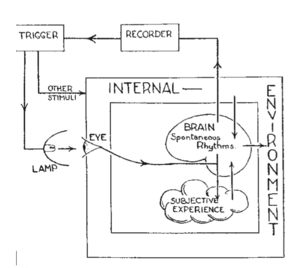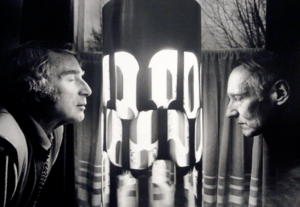User:Stonestone/secondessayfort2stone: Difference between revisions
Stonestone (talk | contribs) No edit summary |
Stonestone (talk | contribs) |
||
| Line 42: | Line 42: | ||
====Space-out==== | ====Space-out==== | ||
=====Brainwaves===== | =====Brainwaves===== | ||
Brainwaves has been mentioned earlier. It plays an important role in space-out experience. | Brainwaves has been mentioned earlier. It plays an important role in space-out experience. The blinky lights made by dreamachine produce about 20 hz brainwaves in our brain, in a way, it is within or close to the range of alpha wave, which will bring people the feeling of deep relaxation vice versa. Besides alpha wave, there is also beta wave, thelta wave and Gama wave which shows different states of our brain. | ||
The frequency of are around 7 to 13 pulses per second,and our brain do not lose its consciousness. | |||
====Visual Speed==== | ====Visual Speed==== | ||
Revision as of 15:40, 14 April 2016
Dreamachine -- To Create Space-Out
Introduction
Space-out is a feeling that people can never tell exactly what is by themselves which can be seen as the soul leaving the body. The views that people see in front of them when their minds escape from their bodies, are diverse and different from the others and difficult to tell clearly. However, the trigger points of space-out are quite similar, drugs, alcohol even some specific visuals, for example. Dreamachine, as one of the most critical patent of triggering space-out, also known as a piece of art work, is a good example to explore the phenomenon of space-out. In this essay, I will give my research on how dreamachine make efforts on people and why people get the feeling of space-out.
Flicker
“Flicker” is a long-standing term of art in experimental psychology, referring to visual effects induced by flickering lights. In 1945, Dr. W. Grey Walter applied flicker into his EEG research, in the end an electronic stroboscope was invented. After an experiment in a big range of people, Dr Walt got the feedbacks (strange feelings) from samples he chose, which were:" faintness or swimming in the head"; "unresponsive or unconscious for a few moments"; "the limbs jerked in rhythm with the flashes of light."
As shown in the diagram on the right, eyes receive the lights from the strobes (lamp) as an subjective experienced signal which is transmitted to our brain, then, the signal (brainwave) goes through the recorder make efforts on the trigger.This loop can be seen as the basic prototype of how the visual flicker we look at works on our brain.
" We all noticed a peculiar effect . . . a vivid illusion of moving patterns whenever one closed one’s eyes and allowed the flicker to shine through the eyelids. The illusion . . . takes a variety of forms. Usually it is a sort of pulsating check or mosaic, often in bright colours. At certain frequencies—around 10 per second—some subjects see whirling spirals, whirlpools, explosions, Catherine wheels. "
Dr Walter noted after experimented with strobes on himself.
Cybernetics(on going)
As a basic question of cybernetics: "how people's brain thinks" can be noted here. There is no doubt that modern consciousness is more and more affected by technology as the modernity
Dreams and visions are at the edges of modern consciousness. This is the non modernity of cybernetics, once more. Second, this research points again to the psychiatric matrix in which Walter’s cybernetics developed. Third, experiments aimed at inducing quasiepilieptic fits in school children should only make us grateful for the controls on human-subjects experimentation that have since been introduced.66 Fourth, flicker is a nice exemplification of my notion of a technology of the self, a material technology for the production of altered states. If you want a paradigmatic example of a technology of the nonmodern self, think of flicker. Fifth and finally, Shippy’s feedback circuit deserves some reflection. In the basic flicker setup the brain was pinned down in a linear relation to the technology. The technology did something—flickered—and the brain did something in response—exhibited epileptic symptoms. This counts as a piece of ontological theater inasmuch as it thematizes the performative brain, the brain that acts rather than thinks. But it does not thematize the adaptive brain, the key referent of cybernetics per se: there is no reciprocal back-and-forth between the brain and its environment. ---
However, those illusions are similar to the hallucinogenic effects of psychoactive drugs such as LSD and mescaline, which is one of the most important reason why it becomes popular in 1960s and led to the invention of dreamachine.
From Dr Walt to Brion Gysin
Dreamachine(on going)
In the post-World War II era, the Beat Generation rediscovered the drug-like strobe-machine by reading Dr Walt's book The Living Brain. It starts with an experience of Brion Gysin, a painter, writer, sound poet, and performance artist born in Taplow, Buckinghamshire. In his dairy he wrote:" Had a transcendental storm of colour visions today in the bus going to Marseilles. We ran through a long avenue of trees and I closed my eyes against the setting sun. An overwhelming flood of intensely bright colors exploded behind my eyelids: a multidimensional kaleidoscope whirling out through space. I was swept out of time. I was out in a world of infinite number. The vision stopped abruptly as we left the trees. Was that a vision? What happened to me? "
After reading Dr Walt's book The Living Brain which was lent by William S. Burroughs, Gysin had found the answer. That is also the critical point of the relationship establishing between Flicker and Dreamachine; Walt and Gysin. Afterwards, Gysin built the Dreamachine in the early 1960's by putting a cylinder with holes onto a record player turn tablewith a 100 watt lightbulb in the middle. When the record player being set to spin at 78 round per minute, the strobes turns into the visual of sitting in a bus and passing shades of leaves under the sun, which makes the light flickers at a frequency of about 20Hz Alpha brainwaves which are associated with subconsciousness.
With bringing the changes of brainwaves to people, dreamachine is displayed as an art piece in by Brion
Gysin displayed Dream Machines as art objects in a series of exhibitions and argued that they marked a break into a new kind of art that should displace all that had gone before: “What is art? What is color? What is vision? These old questions demand new answers when, in the light of the Dream Machine, one sees all ancient and modern abstract art with eyes closed” (Gysin quoted by Geiger 2003, 62).74 Gysin was also taken with the idea of the Dream Machine as a drug-free point of access to transcendental states, and had plans to develop it as a com- mercial proposition, something to replace the television in people’s living rooms, but all his efforts in that direction failed (Geiger 2003, 66 & passim). And in the end, the flicker technology that entered popular culture was not the cheap Dream Machine but the hi-tech strobe light.75 As Geiger puts it (2003, 82–83): “By 1968 . . . stroboscopic lights were flashing everywhere. They . . . had been taken up by the drug culture. Ken Kesey featured strobe lights in his ‘Acid Tests’—parties where he served guests LSD-laced Kool-Aid to the music of the Grateful Dead. . . . Tom Wolfe wrote in The Electric Kool- Aid Acid Test: ‘The strobe has certain magical properties in the world of acid heads. At certain speeds stroboscopic lights are so synched in with the pattern of brain waves that they can throw epileptics into a seizure. Heads discovered that strobes could project them into many of the sensations of an LSD experience without taking LSD.’ ” Flicker, then, was an axis along which Walter’s cybernetics played into the distinctive culture of the high 1960s.76 And Walter himself was happy to claim a share of the credit. In a 1968 talk he remarked,“Illusory experiences produced by flashing lights . . . nowadays are used as a standard method of stimulation in some subcultures. I should be paid a royalty because I was the first to describe these effects” (quoted by Geiger 2003, 83). --
Space-out
Brainwaves
Brainwaves has been mentioned earlier. It plays an important role in space-out experience. The blinky lights made by dreamachine produce about 20 hz brainwaves in our brain, in a way, it is within or close to the range of alpha wave, which will bring people the feeling of deep relaxation vice versa. Besides alpha wave, there is also beta wave, thelta wave and Gama wave which shows different states of our brain. The frequency of are around 7 to 13 pulses per second,and our brain do not lose its consciousness.
Visual Speed
Nosebleed - to create space-out
Conclusion
Reference
Nic Sheehan, Flicker, 1997, Documentary, 1:12:02
B.C. ter Meulen D. Tavy B.C. Jacobs, From Stroboscope to Dream Machine: A History of Flicker-Induced Hallucinations, Eur Neurol 2009 pp316–320
Thomas Budzynski, Ph. D., The Clinical Guide to Sound and Light, 2006
David Siever The Application of Audio-Visual Entrainment for the Treatment of Seniors 2004
Luciana Haill ICT & Art Connect : Revelations by Flicker, Dreamachines and Electroencephalographic Signals in Art
http://www.permuted.org.uk/Flickers.htm
http://www.slideshare.net/holcombea/uws-june2013for-slideshare
http://briongysin.com/


